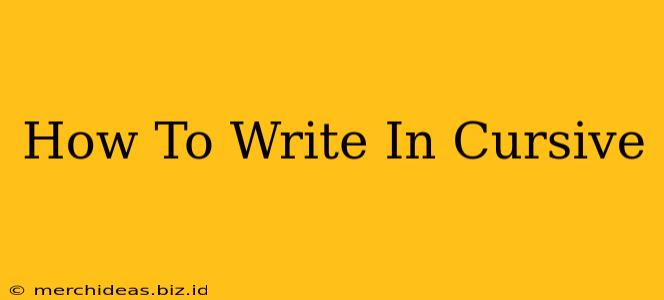Learning cursive handwriting might seem like a relic of the past, but mastering this elegant script offers numerous benefits. It improves fine motor skills, boosts memory retention, and adds a touch of personal flair to your writing. This guide provides a comprehensive, step-by-step approach to learning cursive, perfect for both beginners and those looking to refresh their skills.
Getting Started: The Necessary Materials
Before you begin your cursive journey, gather these essential supplies:
- Cursive handwriting workbook: A workbook specifically designed for learning cursive is invaluable. These workbooks usually provide clear instructions, practice exercises, and letter formations.
- Pen or pencil: Choose a pen or pencil that feels comfortable in your hand and allows for smooth writing. Many find that a fine-point pen offers better control initially.
- Good quality paper: Use paper that’s neither too thin nor too thick. Thicker paper is generally preferred to prevent ink bleed-through.
Mastering the Basics: Letter Formation and Practice
Cursive writing is all about connecting letters seamlessly. The key is to practice forming each letter correctly before moving on to words and sentences.
1. Understanding the Starting Points:
Most cursive letters begin with a specific starting point. Your workbook will show you the correct placement for each letter. Pay close attention to these starting points to ensure consistency.
2. Connecting the Letters:
This is the core of cursive writing. Each letter flows smoothly into the next, without lifting the pen. Practice connecting different letter combinations until the movements become automatic.
3. Consistent Slant and Size:
Maintaining a consistent slant and letter size enhances readability. Strive for uniformity throughout your writing.
4. Practice, Practice, Practice:
Consistent practice is crucial. Start with individual letters, then progress to simple words, and finally, work your way up to sentences and paragraphs. Dedicate at least 15-20 minutes of practice daily for optimal results. Don't be discouraged if it feels awkward at first; it takes time and dedication.
Common Cursive Letter Challenges and Solutions
Several letters present unique challenges for beginners. Here’s how to overcome them:
1. The tricky 'f', 'g', 'j', and 'y': These letters have loops and require careful attention to their downward strokes. Practice the loops repeatedly until they feel natural.
2. Distinguishing between similar letters: Some lowercase letters, like 'u' and 'n' or 'a' and 'o', might appear similar. Focus on the specific shapes and connecting strokes to avoid confusion.
3. Maintaining consistent spacing: Ensure you leave appropriate space between words and letters. Overcrowding makes cursive difficult to read.
Beyond the Basics: Refining Your Cursive
Once you feel comfortable with the basic letter formations, you can start working on these aspects:
- Speed: With continued practice, your speed will gradually increase. Focus on maintaining legibility while increasing your writing speed.
- Style: Explore different cursive styles. Different styles can reflect your personality and preferences.
- Joining Uppercase and Lowercase letters: Pay attention to how upper and lower case letters connect smoothly within words and sentences.
Resources to Enhance Your Cursive Learning
To improve your experience, consider the following options:
- Online videos: Numerous online tutorials provide visual guidance on cursive letter formation.
- Cursive writing apps: Apps offer interactive exercises and feedback, making learning more engaging.
- Cursive fonts: Practicing with cursive fonts on your computer can provide additional visual reinforcement.
Conclusion: Embrace the Elegance of Cursive
Learning cursive takes time and effort, but the rewards are well worth it. With dedication and consistent practice, you can master this elegant script and enjoy the benefits it offers. So, grab your pen and paper, and start your cursive journey today! Remember to be patient with yourself and celebrate your progress along the way. The beauty of cursive lies in the personalized flow and elegance of your own unique handwriting.
